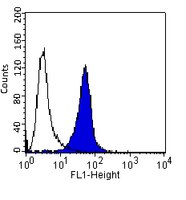Helicobacter pylori CagL dependent induction of gastrin expression via a novel αvβ5-integrin-integrin linked kinase signalling complex.
Wiedemann, T; Hofbaur, S; Tegtmeyer, N; Huber, S; Sewald, N; Wessler, S; Backert, S; Rieder, G
Gut
61
986-96
2011
Abstract anzeigen
One of the most important hormones in the human stomach is the peptide gastrin. It is mainly required for the regulation of gastric pH but is also involved in growth and differentiation of gastric epithelial cells. In Helicobacter pylori infected patients, gastrin secretion can be upregulated by the pathogen, resulting in hypergastrinaemia. H pylori induced hypergastrinaemia is described as being a major risk factor for the development of gastric adenocarcinoma.In this study, the upstream receptor complex and bacterial factors involved in H pylori induced gastrin gene expression were investigated, utilising gastric epithelial cells which were stably transfected with a human gastrin promoter luciferase reporter construct.Integrin linked kinase (ILK) and integrin β5, but not integrin β1, played an important role in gastrin promoter activation. Interestingly, a novel CagL/integrin β5/ILK signalling complex was characterised as being important for H pylori induced gastrin expression. On interaction of H pylori with αvβ(5)-integrin and ILK, the epidermal growth factor receptor (EGFR)→Raf→mitogen activated protein kinase kinase (MEK)→extracellular signal regulated kinase (Erk) downstream signalling cascade was identified which plays a central role in H pylori gastrin induction.The newly discovered recognition receptor complex could be a useful target in treating precancerous conditions triggered by H pylori induced hypergastrinaemia. | 22287591
 |
PEAZ-1: a new human prostate neoplastic epithelial cell line.
Schmelz, M, et al.
Prostate, 48: 79-92 (2001)
2001
Abstract anzeigen
BACKGROUND: The generation of prostatic cell lines provides in vitro models for experimental studies of the pathogenesis of prostate carcinoma. Therefore, we established and characterized a new human prostate epithelial cell line, PEAZ-1 (prostate epithelial Arizona-1). METHODS: The PEAZ-1 cells were grown from a primary human prostate carcinoma specimen obtained from radical prostatectomy. The isolated cells were characterized by immunobiochemistry, immunohistochemistry, and tumorigenicity studies. RESULTS: PEAZ-1 cells are near diploid, tumorigenic, and androgen independent for cell growth. PEAZ-1 cells express N-cadherin, alpha- and beta-catenins, and p120 at cell-cell contacts, cytoplasmic laminin 5, vinculin, paxillin, and phosphotyrosine at focal adhesions, vimentin, and cytokeratins 8 and 18. They do not express plakoglobin, E-cadherin, and PSA, and do not form desmosomes and hemidesomomes. PEAZ-1 respond to ocadaic acid, a pro-apoptotic agent, by expression of p53. CONCLUSIONS: PEAZ-1 cells is a human prostate cancer cell line that has a number of mesenchymal characteristics. | 11433418
 |












